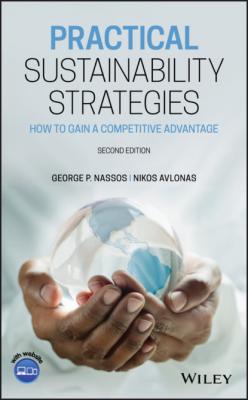ТОП просматриваемых книг сайта:
Practical Sustainability Strategies. George P. Nassos
Читать онлайн.Название Practical Sustainability Strategies
Год выпуска 0
isbn 9781119561095
Автор произведения George P. Nassos
Жанр Химия
Издательство John Wiley & Sons Limited
There are some scientists, while in the minority, who believe that global warming may exist and/or it is not anthropological. Regardless, reducing carbon dioxide emissions is like an insurance policy. If one assumes that global warming does exist and therefore takes the necessary action, the downside risk is minimal. If we learn in 20 years that global warming never really existed, it would have resulted in unnecessary development of renewable energy sources and possible introduction of a carbon tax. If on the other hand, one assumes that global warming does not exist and therefore takes no action at all, what would happen if this assumption is eventually determined to be incorrect. The result to the world population could be catastrophic with rising sea levels leading to flooding and droughts leading to dwindling food production.
POPULATION GROWTH
Each of the environmental issues described earlier, consumption, fossil fuel reserves, water scarcity, and climate change are all related to the world population. Figure 1.4 [20] provides a summary of the historical as well as the projected growth in population.
FIGURE 1.4 World population growth.
The world population reached 1 billion people in 1804, 2 billion in 1927, 5 billion in 1987, 6 billion in 1999, and 7 billion in 2011 [21]. In 2019, the world population is 7.7 billion and growing at a rate of 10 million people every 6.3 weeks [22]. Most of this growth is in the developing countries, which may not be a major problem because of the lower consumption rate. However, as indicated earlier some of these economies are increasing as are their consumption rates. China and India are examples of such growing economies.
THE ENVIRONMENT'S BIG FOUR
Today these are the four major environmental concerns in the world, specifically:
Water quality and quantity
Depletion of natural resources
Climate change resulting primarily from fossil fuels
Population growth—eventually exceeding the earth's capacity
Mitigating the impact of these four major environmental issues leads to an urgency for sustainable development.
REFERENCES
1 1. Brower D. Let the Mountains Talk, Let the Rivers Run: A Call to Those Who Would Save the Earth. San Francisco, CA: Harper Collins; 1995.
2 2. The Holy Bible, Genesis 1: 1–31.
3 3. Available at https://www.ecowatch.com/one-third-of-commercial-fish-stocks-fished-at-unsustainable-levels-1910593830.html. Accessed 2019 Dec 14.
4 4. Available at https://en.wikipedia.org/wiki/Deforestation. Accessed 2019 Dec 14.
5 5. Available at https://phys.org/news/2012-10-wetlands.html. Accessed 2019 Dec 14.
6 6. Available at https://www.nationalgeographic.com/environment/habitats/grassland-threats. Accessed 2019 Dec 14.
7 7. Available at https://www.worldwildlife.org/threats/water-scarcity. Accessed 2019 Dec 14.
8 8. Available at https://www.footprintnetwork.org/our-work/ecological-footprint. Accessed 2019 Dec 14.
9 9. Meadows D, Randers J, Meadows D. The Limits to Growth: The 30-Year Update. White River Junction, VT: Chelsea Green Publishing Company; 2004.
10 10. Strauss M. Got corn? Smithsonian Magazine, p. 25, April 2012.
11 11. Diamond J. What's your consumption factor?. New York Times, 2008 Jan 2.
12 12. U.S. Geological Survey. https://www.gao.gov/assets/670/663343.pdf. Accessed 2019 Oct 24.
13 13. Hoekstra AY (ed.). Virtual Water Trade: Proceedings of the International Expert Meeting on Virtual Water Trade. Delft, The Netherlands: IHE Delft; 2003.
14 14. Hubbert MK. Nuclear energy and the fossil fuels. Presented before the Spring Meeting of the Southern District, American Petroleum Institute, San Antonio, TX; 1956 Mar 7–9.
15 15. Available at https://ourworldindata.org/how-long-before-we-run-out-of-fossil-fuels. Accessed 2019 Dec 14.
16 16. Available at http://350.org/en/about/science. Accessed 2019 Dec 14.
17 17. Available at http://www.columbia.edu/∼jeh1/2008/TargetCO2_20080407.pdf. Accessed 2019 Dec 14.
18 18. Available at https://350.org. Accessed 2019 Dec 14.
19 19. Gillis J. Heat trapping gas passes milestone, raising fears. New York Times, 2013 May 10.
20 20. Lester Brown. Available at https://www.treehugger.com/corporate-responsibility/when-population-growth-and-resource-availability-collide.html. Accessed 2009 Feb 17. Accessed 2019 Dec 14.
21 21. U.S. Census Bureau. https://en.wikipedia.org/wiki/World_population_milestones. Accessed 2019 Oct 24.
22 22. Available at https://www.worldometers.info/world-population. Accessed 2019 Dec 14.
CHAPTER 2 Development of the Sustainability Concept and CSR
In 1983, the United Nations convened the World Commission on Environment and Development and was chaired by Dr. Gro Harlem Brundtland who was the Prime Minister of Norway at the time. The agenda of this commission was the concern with the accelerating deterioration of the human environment and natural resources and the consequences of that deterioration for economic and social development. The final report was published

